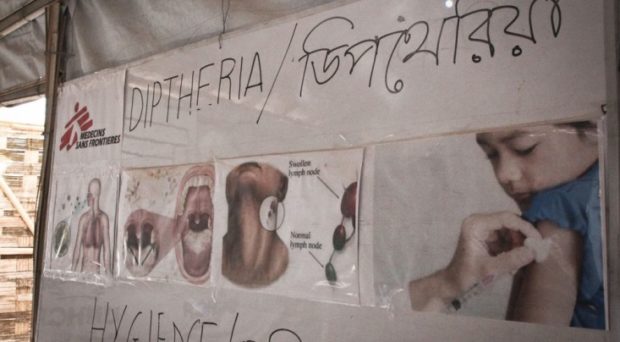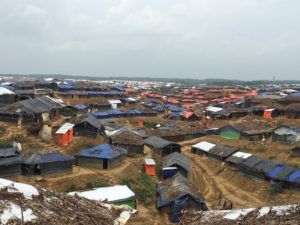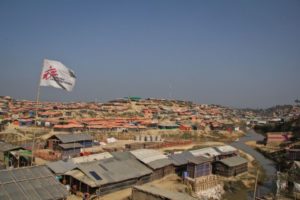
Diphtheria is a bacterial infection and was a major cause of childhood illness and death in the early 20th Century, before a vaccine was developed in the 1920s. It was later included in the WHO’s Expanded Programme on Immunization in the 1970s. In the following decades cases dropped dramatically to the point where the disease was rarely seen in many countries – between 2004 and 2017, there were only two diphtheria cases in the United States.

Unfortunately, diphtheria outbreaks can still occur in places with poor living conditions like low vaccination coverage, reduced access to healthcare, limited access to water and sanitation, and high population density. In late 2017, one such place was a cluster of several large refugee camps in Cox’s Bazar district at the southeastern tip of Bangladesh.
On November 10, 2017, a suspected case of diphtheria was reported at a Médecins Sans Frontières (MSF) clinic in Cox’s Bazar district, Bangladesh. Between August and December 2017, over 625,000 ethnic Rohingya had fled into the area from neighboring Myanmar, settling in makeshift camps.
The site would become the world’s largest refugee camp, with evidence that there had been a long-term lack of healthcare access among these individuals. According to one survey performed by MSF in November 2017, less than a quarter of the children in the camps aged between 6 months and 5 years had been vaccinated against measles.
Our forecasts helped to inform MSF’s outbreak response plans – for example in terms of staffing and supply of diphtheria antitoxin used to treat severe cases …
MSF had previously worked with quantitative researchers at the London School of Hygiene & Tropical Medicine (LSHTM) during other infectious disease outbreaks, including Ebola and cholera.
When the diphtheria outbreak in Cox’s Bazar started to grow in scale, the organizations collaborated to analyze the situation and develop analytical tools and mathematical models that could forecast how the outbreak might unfold. Our forecasts helped to inform MSF’s outbreak response plans – for example in terms of staffing and supply of diphtheria antitoxin used to treat severe cases – and to advocate for control measures with partners.
… the first forecast overestimated the outbreak size, but forecasts improved dramatically in late December, when the epidemic started to slow down.
When we evaluated the performance of our models in the aftermath of the outbreak, we found that the first forecast overestimated the outbreak size, but forecasts improved dramatically in late December, when the epidemic started to slow down. This is a common challenge when forecasting disease outbreaks, and our analysis highlighted several factors that could be improved in the future – such as the speed of model development and the type of model used – as well as other issues, like data quality, that are always a challenge in emergency situations like this.

Besides these technical insights, our work showed that to maximize the benefits of real-time modeling for future outbreaks, we should encourage long-term, sustainable collaborations between epidemiological modelers and the organizations working on the outbreak response.
For mathematical models to realize their full potential and to prevent analysis that is disconnected from the field-reality, communication between outbreak responders and modelers is key. This can enable modelers to appreciate the context and operational challenges involved, and likewise help responders to understand the capabilities and limitations of models.
… relatively simple analysis of available data can help improve understanding of ongoing outbreaks and guide the resulting response.
Our study is a good example of why epidemiological analysis and modeling should be routinely incorporated in outbreak response, and why modelers should be involved at all stages, ranging from data collection, curation and analysis to intervention design and evaluation.
Building on this work, author Flavio Finger spent several weeks in Bangladesh in early 2018 assisting partners with ‘on-the-ground’ data analysis. He was struck by the complexity of the situation there and the sheer scale of the humanitarian crisis, but also by how relatively simple analysis of available data can help improve understanding of ongoing outbreaks and guide the resulting response.
Comments